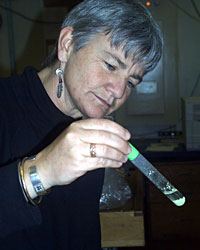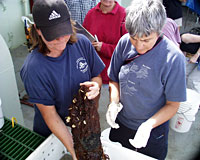| Interviews: Microbiologist Anna-Louise
Reysenbach
 Anna-Louise calls microbes “the chemists of the world” because
they are able to catalyze many reactions that would otherwise be very
slow. Of her microbiology research, she says she is driven by “the
search for the unknown.” Anna-Louise calls microbes “the chemists of the world” because
they are able to catalyze many reactions that would otherwise be very
slow. Of her microbiology research, she says she is driven by “the
search for the unknown.”
To relax Anna-Louise hikes in the Oregon mountains with her dog Saskia,
a mixed golden retriever-collie, and sailboards on the Columbia River.
She enjoys pottery, weaving and knitting (she made the purple wool
hat that she is wearing on the Interviews page during this expedition).
Question:
What did you want to be when you grew up?
Anna-Louise:
A scientist. I was always interested in science as a child. My parents encouraged me to look at nature and we spent many holidays camping, fishing and sailing off the South African coast. In college I learned to scuba dive and realized that I wanted to have a career where I could combine my love for scientific research with my love for the ocean and water sports. So I chose a research career that would keep me near water and outside.
Question:
What schools did you attend?
Anna-Louise:
I attended college at the University of Witwatersrand in South Africa, where I majored in botany and microbiology. I took a lot of courses in marine and aquatic sciences and studied algae. I went right into graduate school after finishing my bachelor’s degree. I attended the University of Cape Town and did my doctorate research on the microbes used in various industrial processes.
Question:
How did you launch your professional science career?
Anna-Louise:
After I earned my Ph.D., I decided to work on extremophiles. These are microorganisms that live in extreme types of environments such as at very high pressures or high temperature. At that time, considerable work was being done in the US on extremophiles, so in 1988 I got a post-doctoral position with Dr. Jody Deming at the University of Washington in Seattle. There I gained experience isolating hypothermophile microorganisms from deep-sea hydrothermal vents (these are microorganisms that live at temperatures greater than 80°C).
 |
 |
| Anna-Louise and Biologist Shana Goffredi examine a mussel-covered chunk of the black smoker chimney. |
Question:
How did you become involved in your current research?
Anna-Louise:
In 1990 I realized that one of the keys to looking at extreme microorganisms is identifying them genetically. At that time, medical researchers were using molecular tools to fingerprint and identify organisms. It seemed logical that I should gain that experience. Like many scientists, we often get new scientific insights by using new techniques. Professor Norman Pace at Indiana University was already using molecular tools in his studies of microorganism, so I applied for a research position to work with him.
Question:
When you are not studying hydrothermal vents, you do research at Yellowstone National Park as well as teach at Portland State University. Tell me about your work at Yellowstone.
Anna-Louise:
I started researching thermophiles at the hot springs there in 1992. My interest in the microbial ecology of deep sea vents is similar to my work at Yellowstone. But it’s a lot easier to walk up to a hot spring and collect a sample than it is to get a sample with ROV Jason. I study the microbial ecology of thermophiles, how they affect their geochemical and geological environment. This will help us interpret fossils from 3.5 billion year old rocks - it’s like working in the present to interpret the past.
Question:
What do you like and dislike about your job?
Anna-Louise:
I love my work, particularly the combination of doing research that involves fieldwork and teaching. There is nothing I really dislike about what I do. I would like to have more time to contemplate science though.
Question:
What excites you about your research?
Anna-Louise:
In the broader perspective, most scientists are driven by a search for “the truth.” The passion I have for my research is driven by this search. So little is known about microbes in high-temperature environments. I want to know what they are doing, how they get their energy and carbon sources, what role they play in the ecosystems they exist in and how they affect geochemical processes. That is a lifetime of work!
|
 Anna-Louise calls microbes “the chemists of the world” because
they are able to catalyze many reactions that would otherwise be very
slow. Of her microbiology research, she says she is driven by “the
search for the unknown.”
Anna-Louise calls microbes “the chemists of the world” because
they are able to catalyze many reactions that would otherwise be very
slow. Of her microbiology research, she says she is driven by “the
search for the unknown.” 